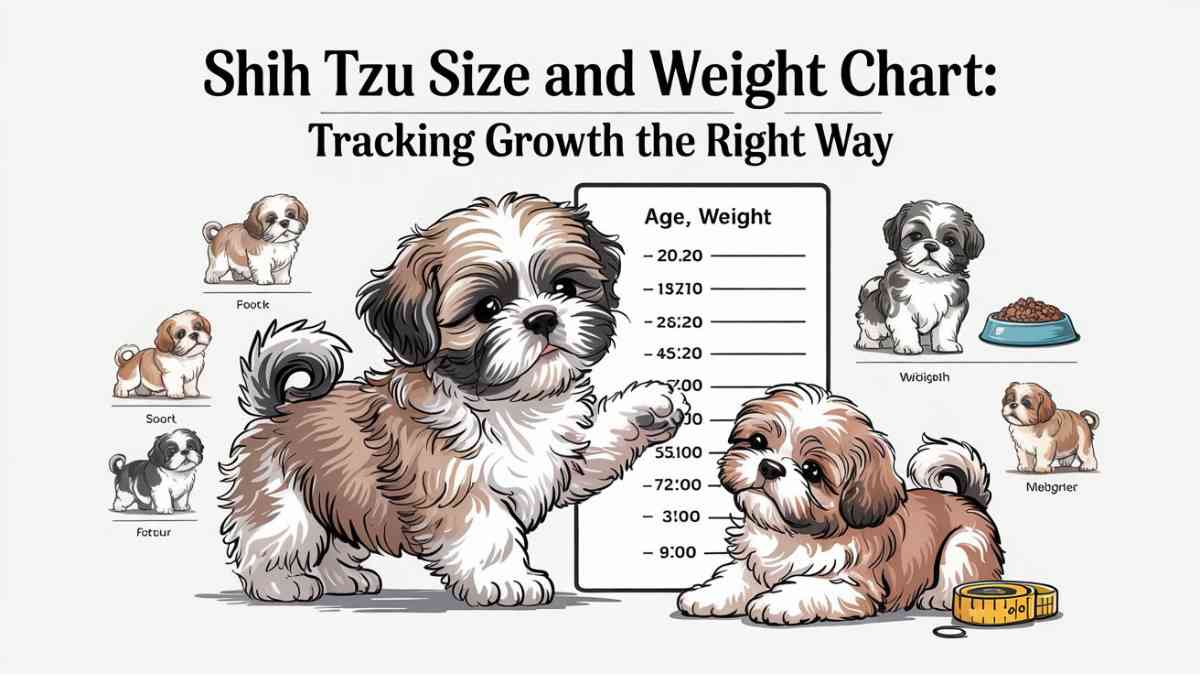Shih Tzu Size and Weight Chart: Tracking Growth the Right Way

Shih Tzus are small in size but full of heart. Known for their loyalty, gentle nature, and elegant double coats, they have become one of the most cherished toy breeds in the world. As a Shih Tzu parent, watching your pup grow is a joy, but it can also come with questions. Are they growing properly? Are they underweight or heavier than they should be? That’s where a well-structured Shih Tzu size and weight chart becomes more than just a reference—it becomes a guiding tool.
What Is a Shih Tzu Size and Weight Chart?
A Shih Tzu size and weight chart is a detailed table that outlines expected weight and height milestones for your dog at various ages. It helps you track growth from puppyhood to adulthood, offering insight into what’s normal and when to seek guidance. By comparing your Shih Tzu’s current stats to this chart, you can better understand their development and health.
Why It Matters
These charts are more than just numbers. They provide reassurance for new pet parents, offer guidance for feeding and health decisions, and even help predict how big your puppy will become. Monitoring growth ensures that your pup is thriving, not just growing.
Early Growth Phases
When Shih Tzus are born, they typically weigh less than a pound. Within just a few weeks, they double in size. From birth to eight weeks, growth is fast but unpredictable. By the time a Shih Tzu reaches eight weeks, they generally weigh between 1.5 to 2 pounds.
At this point, the “rule of 3 or 4” is commonly used: multiply their 8-week weight by 3 or 4 to estimate their adult weight. For example, a puppy weighing 2 pounds at eight weeks may weigh between 6 and 8 pounds as an adult.
From Puppy to Adolescent
Between the ages of 2 and 6 months, your Shih Tzu will experience steady growth. This is a critical time for establishing healthy eating and exercise habits. At three months, most Shih Tzus weigh around 4 to 5 pounds. By six months, they often range from 6 to 10 pounds. While growth in height typically slows after six months, they may still fill out in weight until 12 months or slightly longer.
Adult Size Expectations
According to the American Kennel Club (AKC), a standard adult Shih Tzu typically weighs between 9 and 16 pounds and stands about 8 to 11 inches tall at the shoulder. Some Shih Tzus may fall outside these averages, but as long as they’re healthy and energetic, small variations are usually not a concern.
Teacup and Imperial Shih Tzus
Some breeders advertise “Teacup” or “Imperial” Shih Tzus that are smaller than the breed standard. These dogs usually weigh under 9 pounds as adults. While their petite size may seem appealing, these versions often result from selective breeding that can lead to fragile health. A proper shih tzu weight chart will not typically include teacup varieties, as they fall outside AKC standards.
The Role of Genetics
Just like humans, Shih Tzus inherit much of their growth potential from their parents. If your pup’s parents were on the heavier or taller side, chances are they will be too. That said, diet, lifestyle, and health also play crucial roles.
Feeding for Healthy Growth
Proper nutrition is essential to healthy development. Puppies should be fed high-quality food rich in protein and fats that support muscle and brain growth. At each stage of life, you’ll need to adjust portion sizes and feeding frequency based on their weight and age. Overfeeding can lead to obesity, while underfeeding may cause stunted growth.
When Growth Slows Down
Most Shih Tzus reach their full height by 8 to 10 months, but weight can continue increasing until 12 to 15 months. This is when the body fills out, and the fur begins to grow into its characteristic long, flowing coat. If your Shih Tzu hasn’t gained much weight past 10 months, it’s likely close to its final adult size.
How to Monitor Progress
Use a kitchen or pet scale to weigh your Shih Tzu every two to four weeks. Combine this with a measuring tape for height at the shoulder. Record these numbers in a notebook or app so you can spot trends and catch issues early. Comparing these results to a shih tzu weight chart gives you a clear view of whether your pet is on track.
Red Flags to Watch For
If your Shih Tzu is significantly under or overweight for their age group, it may point to health issues. Warning signs include visible ribs, low energy, or difficulty moving. Sudden weight gain can also be a concern, especially if it comes with breathing problems or reluctance to exercise. Regular vet check-ups are essential for catching problems early.
Benefits of Using a Growth Chart
Growth charts aren’t just about numbers. They help you:
- Predict adult size for better planning
- Adjust feeding routines
- Spot signs of developmental delays
- Prevent obesity through portion control
- Have informed discussions with your vet
Male vs. Female Differences
In many cases, male Shih Tzus tend to be slightly heavier or taller than females, but the difference is usually small. Both genders fall within the same average range and grow at similar rates.
Common Questions from Pet Parents
“How big will my Shih Tzu get?” is one of the most asked questions by new owners. The answer lies in early tracking and knowing the breed standard. The better you understand their individual growth curve, the more confident you’ll feel in supporting their journey.
Don’t Rely on Guesswork
Many pet owners assume small breeds don’t require growth tracking, but this is a mistake. Shih Tzus are prone to both weight gain and dental issues, both of which are easier to manage when spotted early.
No Two Dogs Are the Same
Even with a chart, remember that not all dogs follow the exact same path. Some may grow faster early and slow later. Others may be late bloomers. What matters most is steady progress and overall well-being.
Conclusion
Raising a Shih Tzu is a rewarding experience that comes with unique joys and responsibilities. A Shih Tzu size and weight chart is a tool every caring owner should use—not just for tracking numbers, but for ensuring that your dog is developing in a healthy and happy way. By observing weight trends, maintaining proper nutrition, and working closely with your vet, you create the best conditions for a full, vibrant life for your furry friend.
Keep the chart nearby, weigh regularly, and embrace each phase of growth with love and awareness. Because behind every number is a personality in the making—and a bond that keeps getting stronger.
Track your Shih Tzu’s growth confidently—know what’s normal and when to act.




